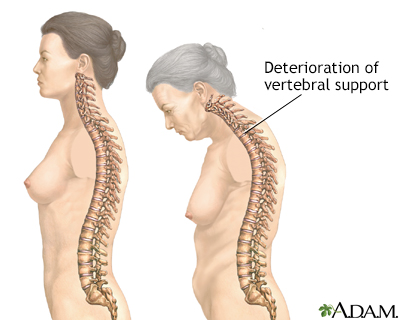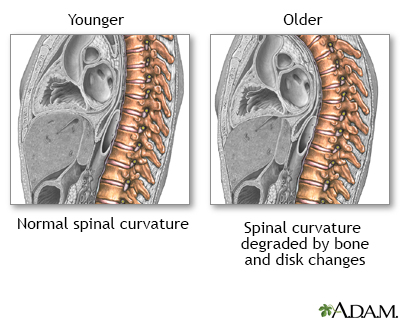Aging changes in body shape
Images


Information
Your body shape changes naturally as you age. You cannot avoid some of these changes, but your lifestyle choices may slow or speed the process.
The human body is made up of fat tissue, lean tissue (muscles and organs), bones, and water. After age 30, people tend to lose lean tissue. Your muscles, liver, kidney, and other organs may lose some of their cells. This process of muscle loss is called atrophy. Bones may lose some of their minerals and become less dense (a process that may lead to a condition called osteopenia in the early stages and osteoporosis in the later stages). Tissue loss reduces the amount of water in your body.
The amount of body fat goes up steadily after age 30. Older people may have almost one third more fat compared to when they were younger. Fat tissue builds up toward the center of the body, including around the internal organs. However, the layer of fat under the skin may become smaller.
The tendency to become shorter occurs among all races and both sexes. Height loss is related to aging changes in the bones, muscles, and joints. As people age, several things can cause height loss:
- The gel-like disks between the vertebrae in the spine dry out and flatten. This shortens the spaces between the vertebrae.
- Muscle loss and loss of core strength can lead to a more stooped posture.
- Feet tend to flatten with age.
- Osteoporosis can cause micro fractures in the spine with decreased height of the vertebrae.
People typically lose almost one-half inch (about 1 centimeter) every 10 years after age 40. Height loss is even more rapid after age 70. You may lose a total of 1 to 3 inches (2.5 to 7.5 centimeters) in height as you age. You can help lessen height loss by following a healthy diet, staying physically active, and preventing and treating bone loss.
Smaller leg muscles and stiffer joints can make moving around harder. Excess body fat and changes in body shape can affect your balance. These body changes can make falls more likely.
Changes in total body weight vary for men and women. Men often gain weight until about age 55, and then begin to lose weight later in life. This may be related to a drop in the male sex hormone testosterone. Women usually gain weight until age 65, and then begin to lose weight. Weight loss later in life occurs partly because fat replaces lean muscle tissue, and fat weighs less than muscle. Diet and exercise habits can play a large role in a person's weight changes over their lifetime.
Your lifestyle choices affect how quickly the aging process takes place. Some things you can do to reduce age-related body changes are:
- Get regular exercise.
- Eat a healthy diet that includes fruits and vegetables, whole grains, and the right amounts of healthy fats.
- Limit your alcohol use.
- Avoid tobacco products and illicit drugs.
References
Shah K, Villareal DT. Obesity. In: Fillit HM, Rockwood K, Young J, eds. Brocklehurst's Textbook of Geriatric Medicine and Gerontology. 8th ed. Philadelphia, PA: Elsevier; 2017:chap 80.
Walston JD. Common clinical sequelae of aging. In: Goldman L, Cooney KA, eds. Goldman-Cecil Medicine. 27th ed. Philadelphia, PA: Elsevier; 2024:chap 24.
BACK TO TOPReview Date: 7/15/2024
Reviewed By: Frank D. Brodkey, MD, FCCM, Associate Professor, Section of Pulmonary and Critical Care Medicine, University of Wisconsin School of Medicine and Public Health, Madison, WI. Also reviewed by David C. Dugdale, MD, Medical Director, Brenda Conaway, Editorial Director, and the A.D.A.M. Editorial team.

Health Content Provider
06/01/2025
|
A.D.A.M., Inc. is accredited by URAC, for Health Content Provider (www.urac.org). URAC's accreditation program is an independent audit to verify that A.D.A.M. follows rigorous standards of quality and accountability. A.D.A.M. is among the first to achieve this important distinction for online health information and services. Learn more about A.D.A.M.'s editorial policy, editorial process and privacy policy. A.D.A.M. is also a founding member of Hi-Ethics. This site complied with the HONcode standard for trustworthy health information from 1995 to 2022, after which HON (Health On the Net, a not-for-profit organization that promoted transparent and reliable health information online) was discontinued. |
The information provided herein should not be used during any medical emergency or for the diagnosis or treatment of any medical condition. A licensed medical professional should be consulted for diagnosis and treatment of any and all medical conditions. Links to other sites are provided for information only -- they do not constitute endorsements of those other sites. © 1997- 2025 A.D.A.M., a business unit of Ebix, Inc. Any duplication or distribution of the information contained herein is strictly prohibited.
